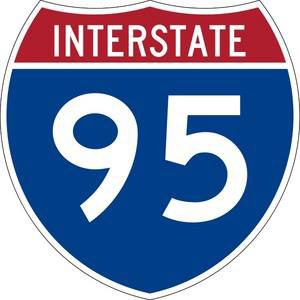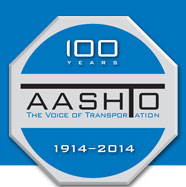
March 26, 2014
More Than Just Another Sign: The Interstate Shield and Its Origins
By AASHTO Information Resource Coordinator Bob Cullen

Many of us have heard, in one form or another, the wise (and very transportation-oriented) saying that it's the journey and not necessarily the destination that matters most. Based on one of my most recent excursions into highway history, I would amend those words by asserting that sometimes our biggest lessons and insights come from the process rather than the end product itself. A case in point: what was involved in coming up with the Interstate Highway System shield that's been very much a part of our lives for more than 56 years now.
The basic story about the Interstate shield is that, after President Dwight D. Eisenhower signed into law the bill creating that nationwide highways network in 1956, one of the challenges was to develop a distinctive marker to be placed along those routes for motorists. The American Association of Highway Officials (AASHO) was charged with proposing that new one-of-a-kind sign. Consequently, over the next several months following the authorization of the Interstate Highway System, the association's Route Numbering Committee received and evaluated dozens of submissions from various states for that sign.
Ultimately, the final version of the shield approved by that committee was one from Texas that had been designed by a state traffic engineer there named Richard Oliver; elements of an entry from Missouri would be incorporated into that version. The AASHO Administration Committee unanimously approved that proposed sign on Aug. 14, 1957, and the Federal Highway Administration subsequently adopted the new shield for usage along Interstate highways across the nation.
That's the essential story of what brought the shield into existence all those years ago, but it wasn't until recently that I found myself challenged to explore a lot more the road that was traveled by AASHO and its member departments to get to that final version. This extra measure of exploration took place as the result of my being interviewed for a radio news story about the shield's origins.
Both the recording and text of that news story can be found here, and — while I don't want to repeat too much of what is already addressed in that story -- I do want to share a couple of my own takeaways from my research leading up to that interview and my conversation with reporter Kenny Malone:
In examining and comparing the various surviving also-ran submissions from the states for that Interstate shield design competition, I was struck by how many incorporated the letter “I” in those entries. My own simple explanation was that, while I'm most definitely not an engineer myself, I have worked closely with enough of them at AASHTO over the years to appreciate that they have a very utilitarian approach to getting things done and that the use of “I” in many of those designs was just a shorthand, bottom-line, no-frills means to help folks know immediately and without ambiguity when they were actually driving along an Interstate highway.
That's a straightforward enough explanation for that particular pattern in the submissions, of course, but I was also intrigued by another common denominator in a number of those surviving entries that go beyond the pragmatic and perhaps into even more intangible territory: the use of symbolism, in one form or another, to signify the nation in which these likenesses of the shield would someday criss-cross.
The examples of this that I found included submissions from New York and New Hampshire that featured entire outlines of what was the 48 contiguous states that comprised the U.S. (Alaska and Hawaii wouldn't join the union for a couple of more years). Then there was the entry from Idaho that depicted that great national symbol, the eagle. Beyond those types of illustrations, there was the submission from somebody in North Carolina that showed not just any “I” but one that was striped in glorious red, white, and blue.
While it's always dangerous to read the minds of others — especially from more than a half-century ago — my own sense from looking through those entries and discussing them in that radio interview was that those engineers and others from the states that submitted designs for the shield were very much aware of something very significant. Namely, that the Interstate Highway System wouldn't be just a whole patchwork of newly paved roads to get people a lot quicker from point A to point B; that it was something bigger than that, something that would matter in the lives of their fellow Americans for years and years to come, an important piece of U.S. history. The shield wasn't just about entries onto and exits off those superhighways; it would be about the land and its people that it would serve.
And this is why I also think that — after all was said and done, and final decision made -- the shield adopted at that time and as we know it today features the red, white, and blue on its design. In an even larger sense, however, I think that the competition for the shield at the dawn of the Interstate era and the fact that all those individuals from all those states participated in that process likewise reflects the feeling of history and enthusiasm early on for that large-scale enterprise.





































